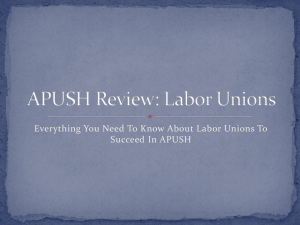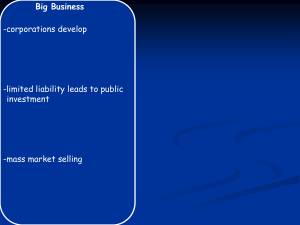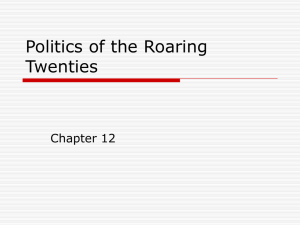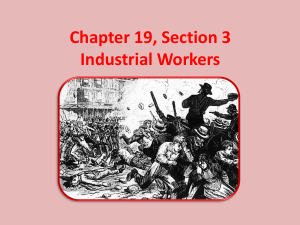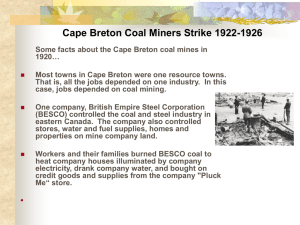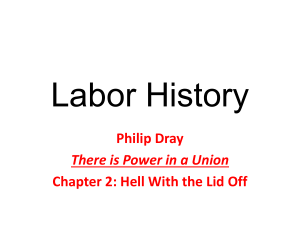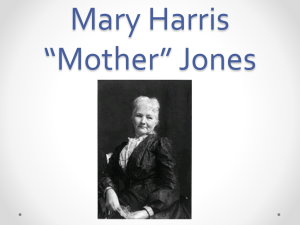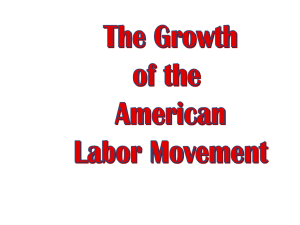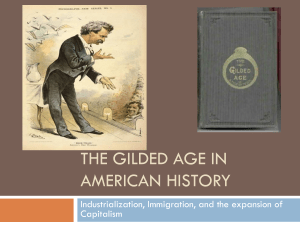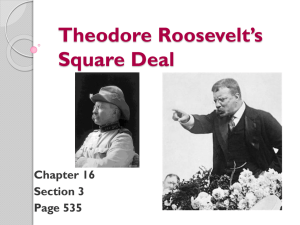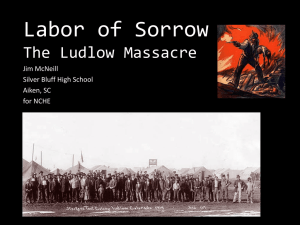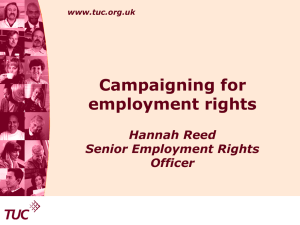The General Strike 1926
advertisement
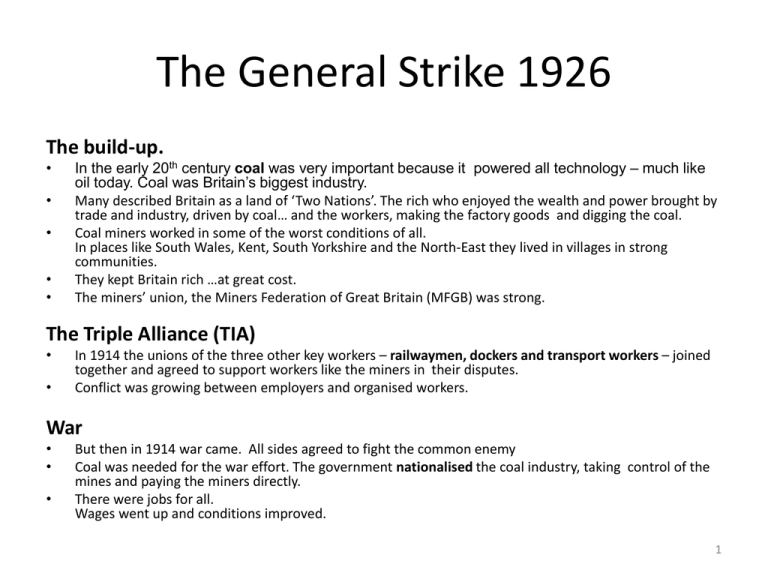
The General Strike 1926 The build-up. • • • • • In the early 20th century coal was very important because it powered all technology – much like oil today. Coal was Britain’s biggest industry. Many described Britain as a land of ‘Two Nations’. The rich who enjoyed the wealth and power brought by trade and industry, driven by coal… and the workers, making the factory goods and digging the coal. Coal miners worked in some of the worst conditions of all. In places like South Wales, Kent, South Yorkshire and the North-East they lived in villages in strong communities. They kept Britain rich …at great cost. The miners’ union, the Miners Federation of Great Britain (MFGB) was strong. The Triple Alliance (TIA) • • In 1914 the unions of the three other key workers – railwaymen, dockers and transport workers – joined together and agreed to support workers like the miners in their disputes. Conflict was growing between employers and organised workers. War • • • But then in 1914 war came. All sides agreed to fight the common enemy Coal was needed for the war effort. The government nationalised the coal industry, taking control of the mines and paying the miners directly. There were jobs for all. Wages went up and conditions improved. 1 The General Strike 1926 • • But prices went up too, and some mine owners were making lots of money for themselves. After the war, they wanted to keep making lots of money. And after the war the government gave the mines back to the private owners. 1921 • • • • The TIA said they would support the miners in a strike. But on the first day of the strike the railway union leader, Jimmy Thomas, refused to act. This was known as ‘Black Friday’. The miners were left alone and the strike failed after a lot of hardship. Crisis • • • • • But then in 1925, a major crisis hit the British coal industry. Exports went down. So the mine owners told the miners: “We’ll cut your wages to what they were 4 years ago…… and we’ll make you work longer hours.” The miners’ leader Arthur Cooke replied: “Not a penny off the pay! Not a second on the day!” The mine owners said if the miners didn’t agree, they’d be locked out with no work and no pay. 2 The General Strike 1926 The Trades Union Congress (TUC) • • • They represented all the workers in unions – dockers, railwaymen, miners, transport workers etc. They also wanted the mines to be nationalised – all run by the government, not by lots of private businesses. The Conservative government – led by Prime Minister Stanley Baldwin – was worried … and they bought time by making a deal with the TUC. ‘Red Friday’ 31 July 1925 • • • The day the government agreed to the subsidy. Some miners thought the government was on their side. In reality the government was buying time. Samuel • In March 1926 the Samuel Commission reported. • • • It said: “No nationalisation, and a pay cut of 13.5%” In other words, it supported the mine owners. … but at the beginning of May the mine owners began a lockout. They hoped poverty and hunger would force the miners to give in. The TUC members were ready to call a strike of two and a half million workers in support of the miners. The leaders of the TUC – Walter Citrine, Ernest Bevin and Jimmy Thomas – didn’t want to go so far … • • 3 The General Strike 1926 Nine days in May • • • Daily Mail workers refused to print an anti-strike editorial. The government pulled out of talks with the TUC. TUC leaders called a general strike in support of the miners. Government tactics. The government planned carefully, supported by the media who portrayed the strike as a threat to parliamentary democracy. • They divided the country into regions, each with a headquarters and strong communication with London. • They piled up food and other resources. • They stockpiled coal. • They organised emergency electricity generation. • They made sure they controlled access to the media and published a newspaper, The British Gazette. • They recruited a large number of special policemen. • They made plans to use the armed forces to maintain supplies, guard key buildings and fight the strikers if necessary. • They set up the Organisation for the Maintenance of Supplies (OMS) to train volunteers as strike breakers, under Winston Churchill. 4 The General Strike 1926 The strike For 9 days two and a half million workers were on strike The TUC were not as well planned as the government. The leaders wanted workers to strike in stages. In fact, millions went on strike on the first day including many that were planned to strike later. The strikers • • • • • closed down docks, public transport, newspapers and many industries. held daily meetings. ran social and sporting events for strikers and their families. tried to stop traffic moving around the country. published a daily newspaper, The British Worker. The BBC The BBC allowed government ministers to make speeches on the radio. The BBC refused to let union leaders or the Labour Party leader. Meanwhile • • • • The strike grew and got stronger day by day. Some workers formed self-defence militias and Councils of Action. There were a few clashes between police and strikers (in London, Newcastle and Glasgow) but it was mainly peaceful. In most places strike leaders and police worked together to avoid violence. Over 5000 strikers were arrested. 5 The General Strike 1926 The strike was growing • • • • Most public transport was stopped. Police and army had to escort lorries from the docks. Some buses and lorries were driven by strike-breaking volunteers. Support for the strike was growing. But... • • • • The TUC leaders did not want to be seen as traitors. They were secretly meeting Sir Herbert Samuel, the man who led the Royal Commission that had looked at miners’ pay in 1925. The TUC did not tell the miners’ leaders about this meeting. The TUC leaders made a deal with Samuel. This said that the miners’ wages might be protected. The TUC then called off the strike on 11th May. The miners felt betrayed. • Now the miners were on their own. The miners betrayed? After the strike ended the government refused to follow the deal with Samuel. Instead they passed a law that made the miners work 8 hours a day. So the miners carried on striking for another 7 months but hunger and poverty finally forced them back to work. Many were victimised. Some strikers were not allowed their jobs back. All miners were forced to accept longer hours and lower wages. In 1927 the British Government passed laws that made it illegal for workers to strike in sympathy with other workers and made it harder to join a trades union. 6 The General Strike 1926 A failure of leadership? Why did the TUC Leaders end the strike? Some possible explanations... • They had not wanted the strike in the first place • They did not want to be seen as trying to wreck the country • They didn’t want a revolution • They didn’t think it would work • They couldn’t control it • They thought the economic situation was so bad that they had to be realistic • They wanted to stop the Communist Party becoming too strong • They were too close personally to the government ministers • They were more on the side of the bosses than the workers THINK In your opinion, was it a political strike or an economic one? If the strike had continued, who would have won? 7
